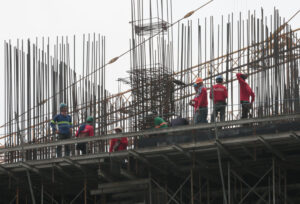




Philippines Trade Update: Exports momentum continues
 DOWNLOAD
DOWNLOAD

Quarterly Economic Growth Release: More BSP cuts to come
 DOWNLOAD
DOWNLOAD

Monthly Economic Update: Fed catches up
 DOWNLOAD
DOWNLOAD


November jobless rate falls to lowest since 2005

The Philippines’ unemployment rate dropped to its lowest level in over 17 years in November, as firms hired more workers ahead of the holiday season.
Preliminary data from the Philippine Statistics Authority’s Labor Force Survey (LFS) released on Friday showed the unemployment rate further eased to 4.2% in November. This was lower than the 4.5% in October and 6.5% a year earlier.
This translated to 2.177 million unemployed Filipinos in November, lower than the 2.241 million in October and the 3.160 million in the same month in 2021.
“This was the lowest unemployment rate since April 2005,” PSA Undersecretary and National Statistician Claire Dennis S. Mapa said during the press briefing on Friday.
The government updated the definition of joblessness in 2005.
Starting April 2005, the PSA adopted the definition of unemployed as those persons (1) without work; and (2) currently unavailable for work; and (3) seeking work or not seeking work because of the belief that no work is available, or awaiting results of previous job application, or because of temporary illness or disability, bad weather, or waiting for rehire or job recall.
Prior to that, joblessness was only considered under two criteria: (1) without work and looking for work; or (2) without work and not looking for work due to valid reasons.
Mr. Mapa said the Philippines was back to its pre-pandemic levels in the July to November round of the Labor Force survey.
“The strong labor market signifies the steady recovery of our economy. With the release of the Philippine Development Plan (PDP) 2023-2028, we are starting our work toward deepening economic and social transformation,” National Economic and Development Authority (NEDA) Secretary Arsenio M. Balisacan said in a statement.
Mr. Balisacan said that the government sees a more dynamic labor market as flexible work arrangements and digitalization provide more employment opportunities for Filipinos.
UNDEREMPLOYMENT RISES
However, job quality deteriorated in November. The underemployment rate slightly rose to 14.4% from 14.2% in October, but this was still lower than 16.8% in November 2021.
In absolute terms, the number of underemployed Filipinos increased to 7.161 million in November, from 6.673 million in October. It was lower than the 7.618 million in November 2021.
Meanwhile, employment rate edged up to 95.8% in November, from 95.5% in October and 93.5% in the same month a year ago. This was the highest employment rate based on available data from April 2005.
This was equivalent to 49.706 million employed Filipinos, higher than the 47.106 million in the previous month and 45.474 million in November 2021.
The size of the Filipino labor force expanded to 51.883 million in November, from 49.348 million in October and 48.634 million in November 2021.
This translated to a labor force participation rate (LFPR) — the share of labor force to the total population 15 years old and over — of 67.5%. This was higher than the 64.2% recorded in October and November 2021.
Mr. Mapa also said that the increase seen in the LFPR is due to seasonality, economic activities related to the holidays and employment in family home establishments.
Year to date, the unemployment rate averaged 5.5%, lower compared with the 7.8% average in the 11 months to November in 2021.
The underemployment rate averaged 14.4% in the same period, down from the 16% last year.
The employed Filipino worker worked 39.3 hours a week on average in November, a tad lower from the 40.2 average weekly hours in October and 39.6 on November 2021.
SERVICES
In November, the services sector was still the top employer, accounting for 60.5% of the labor market. Agriculture followed with 21.4% and industry with 18.1%.
Higher employment was seen in agriculture and forestry (up 247,000 to 9.466 million in November); manufacturing (up 668,000 to 4.335 million); electricity, gas, steam and air-conditioning supply (up 52,000 to 152,000); water supply; sewerage, waste management and remediation activities (up 36,000 to 89,000); wholesale and retail trade; and repair of motor vehicles and motorcycles (up 941,000 to 11.318 million); accommodation and food service activities (up 381,000 to 2.260 million) among others.
Meanwhile, job losses were seen in fishing and aquaculture (down 211,000 to 1.175 million); mining and quarrying (down 4,000 to 233,000); construction (down 408,000 to 4.169 million); transportation and storage (down 39,000 to 3.350 million) among others.
“Unemployment is now easing because we are moving towards the end of the pandemic where employment opportunities have returned and investments are coming in due to a more open economy,” Asian Institute of Management economist John Paolo R. Rivera said in an e-mail.
For ING Bank NV Manila Senior Economist Nicholas Antonio T. Mapa, the improvement in the labor market mirrors the significant pickup in economic activity especially in retail trade, restaurants, and recreation.
He also added that the jump in hiring for manufacturing matches the gains in recent Purchasing Managers’ Index (PMI) numbers.
“Despite the positive steps in both employment and labor force participation, we note the elevated underemployment rate suggesting that despite finding jobs, workers still need more hours or wages likely to cover the rising cost of living,” he said in a Viber message.
S&P Global Philippines’ PMI showed factory output expanded to 52.7 In November indicating a “modest” pace of expansion from 52.6 in October.
“[We] might see a pullback in gains post holidays and if manufacturing slows due to the global downtrend in trade,” ING’s Mr. Mapa said.
“December 2022 should provide still strong employment numbers as was the case in 2021,” University of Asia and the Pacific economist Victor A. Abola said in an e-mail. — A. M. P. Yraola
This article originally appeared on bworldonline.com





 By BusinessWorld
By BusinessWorld